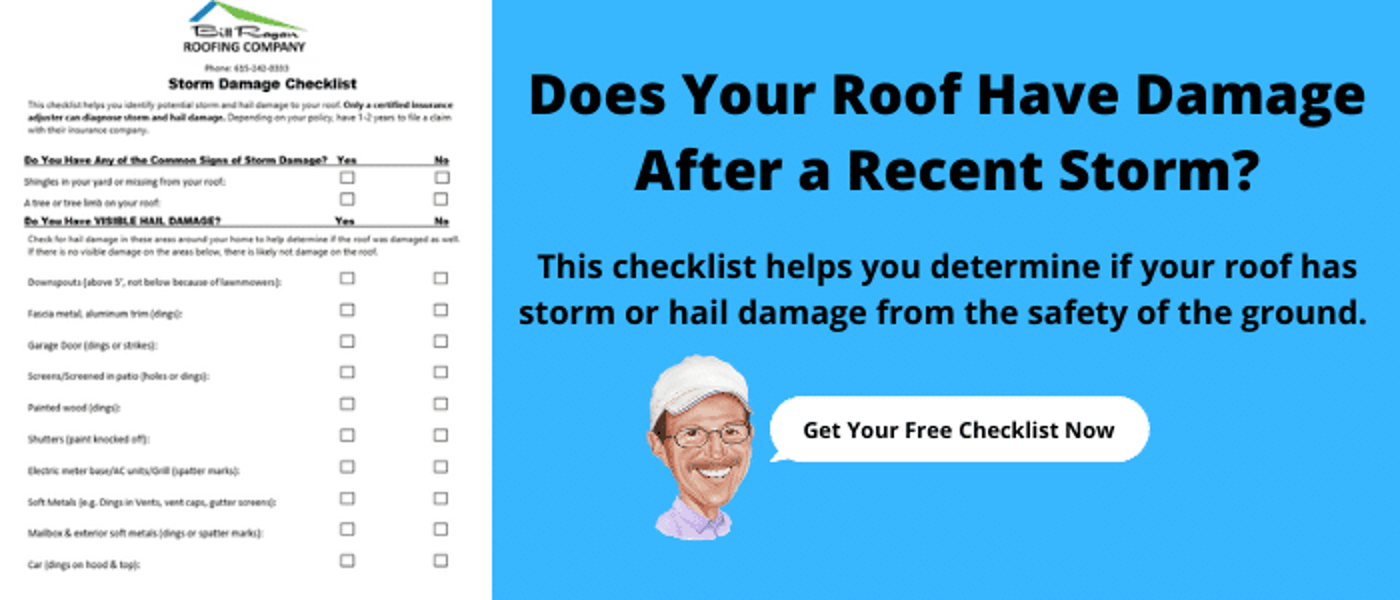How to Negotiate a Full Roof Replacement with Insurance
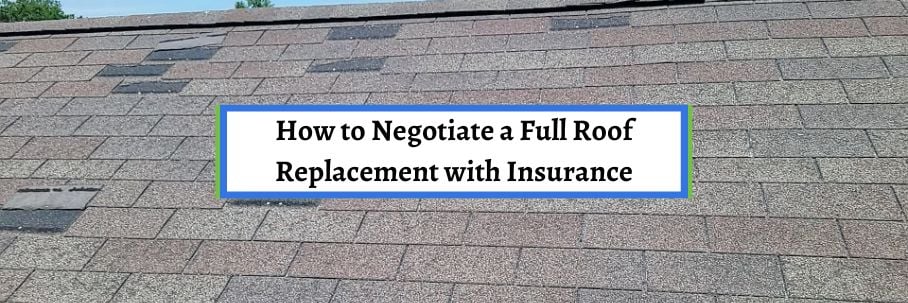
You pay your insurance premiums if a storm damages your roof. So, it’s frustrating when the insurance company only wants to pay to replace some or certain sections of your roof.
This frustration leads to homeowners asking roofing contractors, “How do I negotiate a roof replacement with my insurance company?” While negotiating isn’t necessarily the right word, there are things that give you a better chance of approval and getting the full cost covered.
For over 30 years, the team at Bill Ragan Roofing has guided and advised homeowners going through the insurance claim process. Because of this, I’ll help you understand what you can do to move the approval process forward.
This article provides the following steps to get your insurance claim approved:
- Review your insurance policy to see if it pays for a full roof replacement
- Get photo documentation of roof damage and collateral damage
- Know the options if insurance initially denies your roof damage claim
- Supplement your roof damage insurance claim
- Utilize the ITEL process and matching laws
Review your insurance policy to see if it pays for a full roof replacement
Before starting anything, you need to review your insurance policy to see if you have a leg to stand on. This is because your policy determines if insurance covers and pays for a full roof replacement.
On your insurance paperwork, you’ll either have an Actual Cash Value policy or Replace Cost Value policy. Each policy equals a payout, but the amount insurance gives is very different.
Actual Cash Value policy
If you have an Actual Cash Value (ACV) policy, you only get the depreciated value of your roof. This policy means the insurance company only has to give you what your roof is valued at the time of the claim.
This will not be enough to cover the cost of a full roof replacement, and you’ll have to pay for the rest of it out-of-pocket. You may be able to find a roofing contractor who will do it for the ACV payout, but this guarantees cheap materials and labor.
Unfortunately, this cheaper quality and labor sets your roof investment up for premature failure from the beginning.
Replacement Cost Value policy
If you have a Replacement Cost Value (RCV) policy, insurance gives you what it costs to replace your roof. You’ll first get a check for the actual cost value of your roof while your insurance company holds back recoverable depreciation.
After the job is complete and you prove it was done per the claim, you’ll get a second check covering most or the rest of the cost. Just know the insurance company only pays to restore your new roof to a brand-new version of itself.
If you want to add upgrades, like going from 3-tab asphalt shingles to architectural asphalt shingles, you’ll pay the difference.
Get photo documentation of roof damage and collateral damage
When filing a claim, the insurance company needs clear evidence that it's viable. The best way to do this is to get photo documentation from a roofing contractor during a storm damage inspection.
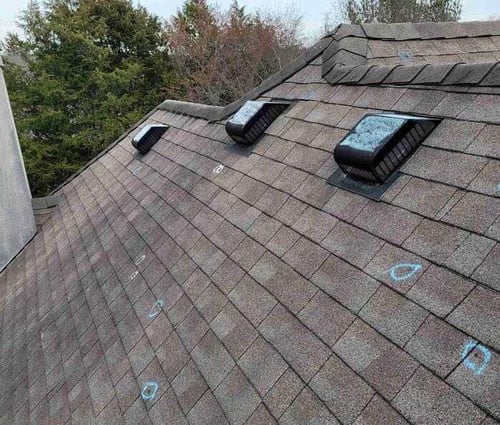
They’ll mark any roof areas with missing shingles, granule loss, hail marks, dents in metal, and anything else that looks like possible storm damage with chalk. This makes it easier to see the damage and creates clear reference points for the insurance.
After marking up the damage on your roof, they’ll take pictures of everything to submit to the insurance company. After your roof is inspected, they’ll also look for and document possible signs of collateral damage on the ground.
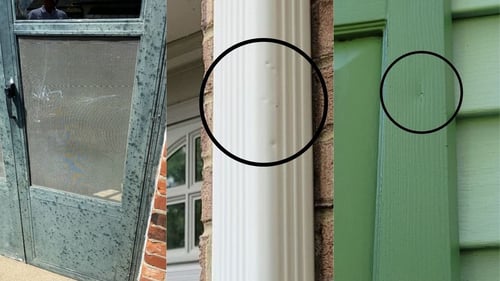
Below is a list of things to check for visible damage from the safety of the ground:
- Dents in downspouts (Above 5 feet, so it can’t be blamed on a lawnmower)
- Dings or strikes to your garage door
- Holes in your window screens
- Dings to any painted wood or shutters
- Splatter marks or dings to your electric meter, AC unit, or grill
- Dents to your mailbox and other soft metals on your property
- Shingles around the property
As I said, photo documentation is the best way to get clear evidence that your roof has storm damage. But even with documentation, it’s not guaranteed that your claim is approved.
Know the options if insurance initially denies your roof damage claim
After reviewing your insurance policy and getting proof, you’re ready to file a claim. If your claim is approved, then half the battle is already done.
However, a denied claim begins the “negotiation process” with your insurance company. Just know that a denied claim from improper installation, inadequate attic ventilation, waiting too long to file, or policy exclusions are legitimate reasons.
But if your claim is denied because they didn’t find damage, you have a few different options. The first thing you should do is ask your insurance company for a second opinion by a different adjuster.
They’ll either approve your claim or agree with the first adjuster that there’s no roof damage. If the second adjuster says no and you still want to fight for the claim, the next step is to contact a structural engineer.
They’ll perform an inspection and offer even more proof to the insurance company that the roof structure needs to be replaced. If even this fails, you’ll either accept the denial or file a complaint with the Commissioner of Insurance in your state.
This is usually the last course of action, and it does work under the right circumstances. But you should only do this if your roof has obvious damage and the insurance company is just being unreasonable.
Supplement your roof damage insurance claim
Once the insurance company approves your claim, you’ll get an estimate for the scope of work required to replace your roof. Unfortunately, insurance adjusters often leave key line items off the estimate.
Some even leave off certain line items required to ensure your roof complies with your state’s building codes. Getting these missing line items covered and approved is where the real negotiation with your insurance company begins.
This form of negotiating is known as supplementing. Supplementing an insurance claim means doing the due diligence and putting in the work to get everything covered in the insurance company’s estimate.
This includes every line item (including local codes), labor, dump fees, overhead, profit, and everything in between. A reputable roofing contractor will help you do this, but every company does it differently.
For example, I provide a checklist with every line item that an insurance estimate should include. This gives our customers the power to go through a claim, add what’s missing, and send it back to their insurance company for approval.
Unfortunately, some insurance companies push back on supplementing, especially around things like overhead. But if you have an RCV policy, the insurance company should pay for everything a roofer needs to do the job correctly while also being profitable.
Utilize the ITEL process and matching laws if insurance won’t replace your entire roof
Even if your insurance claim gets approved, there’s a chance they’ll offer repairs instead of a roof replacement. If this happens, you can just accept the repairs or fight for what your policy is supposed to give you.
You fight by utilizing matching laws (if applicable in your state) and the ITEL process. Let’s take a look at how each one gives you a leg up when negotiating a roof replacement with insurance.
How matching laws lead to a roof replacement from insurance
In Tennessee, we have Law 0780-01-05-.10(1)(b) which states:
“When a loss requires replacement of items and the replaced items do not match in quality, color, or size, the insurer shall replace items so as to conform to a reasonably uniform appearance according to the applicable policy provisions. This applies to interior and exterior losses. The insured shall not bear any cost over the applicable deductible, if any.”
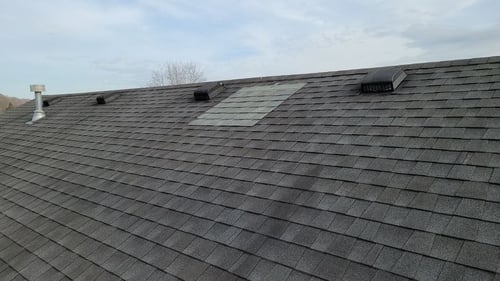 (Non matching asphalt shingles)
(Non matching asphalt shingles)
This law means the insurance company must replace your entire roof if no shingles are available that match your current roof shingle’s color. The shingle could be no longer available, discontinued, out of production, or the color might not match because of wear and tear.
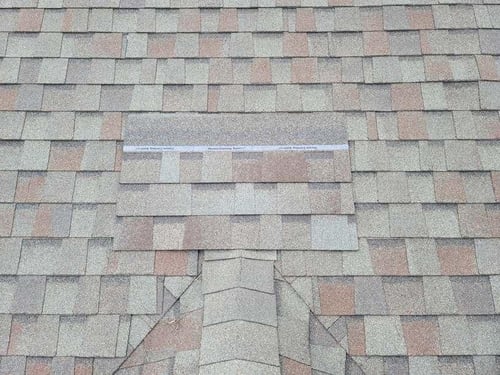 (Shingles that match up almost perfectly; still got approved)
(Shingles that match up almost perfectly; still got approved)
If you live in a matching state and can’t find shingles that match up perfectly with your current roof, the insurance company will have to pay to replace your roof.
How the ITEL process leads to a roof replacement from insurance
If the insurance company fights back on matching, you’ll then utilize the ITEL process. ITEL Laboratories Inc analyzes and matches materials that make up your home, including cabinets, siding, flooring, and roofing.
For roofing specifically, the ITEL report is used to identify your current shingle color and manufacturer. To start the ITEL process, a shingle sample or an entire shingle is sent to the laboratory for analysis.
After analyzing the sample, they’ll provide a report with the brand and specific color of the shingle currently installed on your roof. This report determines if repairs can be done with the same shingle or if your entire roof will need to be replaced due to matching laws.
If the shingles are discontinued or don’t match your current roof’s color, the matching law comes into play. Just know that some insurance policies specifically exclude matching laws.
So, make sure to go over your policy and any exclusions it may have before starting the ITEL process.
How do you find a roofing contractor for your insurance roof replacement?
Now you know what to do and how to “negotiate” a roof replacement with your insurance company. But remember, it’s not really negotiating if it’s what you're owed for paying those insurance premiums.
You may have to put some work in, but the insurance company should pay for a roof replacement if there’s storm damage. The great thing is that you’re not alone in this process because your roofing contractor is there.
Unfortunately, some roofing contractors take advantage of homeowners when insurance is involved. That’s why you need to know how to spot and what to look for in a roofing contractor when getting an insurance roof replacement.
Check out 5 Tips to Hire a Roofing Contractor for a Roof Damage Insurance Claim so you can find a reputable roofer with insurance experience.


